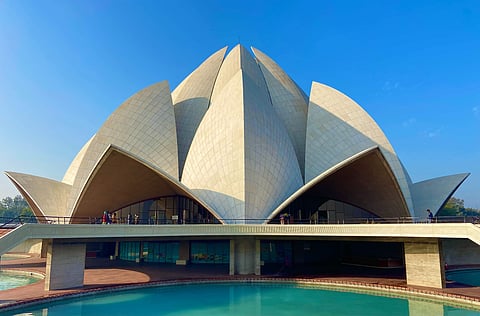
- LIFESTYLE
- FASHION
- FOOD
- ENTERTAINMENT
- EVENTS
- CULTURE
- VIDEOS
- WEB STORIES
- GALLERIES
- GADGETS
- CAR & BIKE
- SOCIETY
- TRAVEL
- NORTH EAST
- INDULGE CONNECT

The flower lotus holds a great significance in art and symbolism. This magnificent aquatic plant has a fascinating history, and it holds a revered status as a symbol of divinity, purity, spiritual enlightenment. Its close relation to water makes it a symbol of universal life. This flower has its own importance in Indian temples and mosques. The delicate unfurling of the lotus petals serves as a profound symbol, representing the continuous expansion of the soul and its inherent capacity for spiritual growth. It signifies the journey towards enlightenment, wherein one rises above the muddiness of worldly attachments, untouched and untainted.
Deeply rooted in religious and spiritual paradigm, the lotus unveils its profound symbolism. Professor Rooman Deb, from St Francis College for Women, states that “Indian religious contexts, the lotus motif finds subtle integration in certain Islamic architectural elements, reflecting the crosscultural influence in regions where Hindu and Islamic traditions intersect.”
Symbolism of lotus in Hindu temple architecture
In Hinduism, lotus holds an immense symbolism, where it represents various aspects of divinity and spirituality. Lord Vishnu, known as the “LotusEyed one,” holds a lotus in his hand, further highlighting the lotus’ connection to divinity. Goddess Lakshmi, the Hindu deity, is often portrayed on a pink lotus flower which emphasises its association with beauty, grace, and abundance. Further more, lotus holds a profound association with the sun and fire deities, serving as a powerful representation of the realisation of inner potential and the harmonious flow of energy through chakras. Lotus is associated with Surya, the Sun God, due to the fact that its petals open as the sun rises and close as the sun sets.
Integration of lotus motifs is seen very often in Hindu temple architecture. One prominent example is the Lotus Temple in New Delhi. It is also termed as Baha’i House of Worship. It was built in 1986, which showcases a three-tier structure of nine petals, resembling a blossoming lotus flower.
Integration of lotus in Islamic architecture
Although the lotus flower is more prominently associated with Hindu religion, it also finds its place in Islamic art and architecture. It is called Nilufar in Persian. They are in the form of arabesque patterns; intricate and symmetrical designs featuring geometric shapes and floral motifs. Towards the conclusion of the Mughal era, the lotus transformed into a mere ornamental element within the design language. However, in certain historical mosques in the Indian subcontinent, such as the Qutub Minar complex in Delhi, lotus motifs are used as a decorative element. Therefore, it is likely due to the influence of the prevalent architectural styles and motifs of the region, which often blends elements from different cultural and religious traditions. The lotus flower’s timeless beauty and profound symbolism continue to captivate and inspire worshipers and art enthusiasts alike, transcending religious boundaries and symbolising the universal quest for spiritual growth.